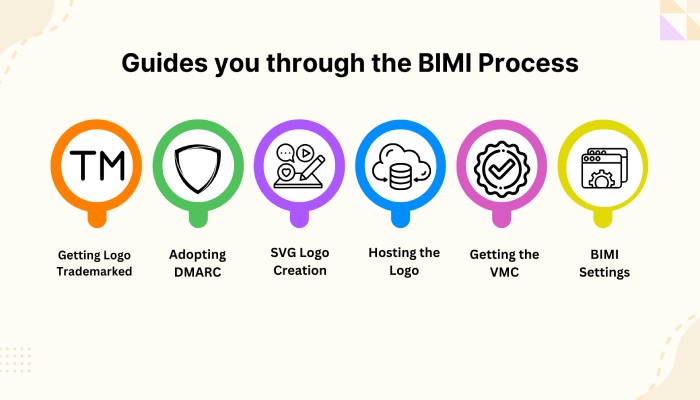No doubt that placing your logo beside every email you send makes your brand stand out in a crowded inbox and boosts engagement. Yes, deploying BIMI helps brands affix their logos to outgoing emails, but this process is somewhat complicated. Establishing trust and integrity in the recipients’ inboxes requires you to prove that the messages are actually sent from legitimate and authorized servers.
This is to prevent malicious people from impersonating you and affixing your credible brand logos next to their fraudulent emails. The complexity of the BIMI process is precisely what enables it to effectively block phishing attempts while helping genuine senders stand out in a cluttered inbox.
Therefore, BIMI requires you to have a properly configured SPF record in place that includes all the mail servers and IP addresses officially authorized by you to send emails on your behalf. SPF is a way to declare that if an email bears our name and logo, but isn’t sent from one of the mail servers or IP addresses mentioned in the SPF record, then don’t trust it. Such emails are either marked as spam (if you have set the ‘Soft Fail’ mechanism) or get rejected (if you have set the ‘Hard Fail’ mechanism).
In short, even with a legitimate Verified Mark Certificate (VMC) and a professional logo, if your SPF record is absent or misconfigured, your emails won’t pass the authentication checks required for BIMI. This will lead to missed branding opportunities that you could have otherwise leveraged by having your emails sit in the targeted recipients’ inboxes.
How does SPF operate?
SPF works by requiring you (the domain owner) to create an SPF record and publish it in your domain’s DNS. An SPF record includes a list of all the mail servers that are allowed to send emails on your behalf. Upon reception, the receiving mail server looks into your SPF record to check if the mail server from which the email is sent is included in the SPF record. If it’s included, the email is placed in the primary inbox; if not, it is either marked as spam or rejected.
In short, SPF works like a guest list for a private event. Only the people (servers/IPs) on the list can “enter the party” (send emails). Anyone outside of the list gets blocked or flagged.
Now, when it comes to showing your brand’s logo next to your email, SPF doesn’t just prove the email is real — it’s one of the basic checks needed to make the logo appear in the inbox.
SPF helps your email clear the first step. Without it, the process stops, regardless of whether you have a Verified Mark Certificate (VMC) and a ready logo. Your logo will only show if your email passes all the required authentication checks, and SPF is one of the first.

Why is SPF required for BIMI and VMC?
SPF is like a security gateway that checks the authenticity of every email sent from your domain. It is deployed by the sending domain but works on the recipient’s end to help it verify whether the emails sent on behalf of your brand are legitimate or potentially fraudulent. Therefore, unless your emails pass this simple authentication check, they won’t proceed to the BIMI process, regardless of any other email security protocols in place.
Therefore, if you have deployed BIMI and want it to display your brand logo efficiently in the recipient’s inbox, the entire chain of trust must be solid. Email providers are not just limited to hosting your emails; they also prioritize security and privacy. That’s why they don’t just display your logo; they first verify that the sender is actually who they are claiming to be and not an impersonator trying to send spoofed messages. And SPF plays a significant role in this verification. Therefore, if your emails are failing SPF checks or you haven’t configured the SPF record yet, BIMI will not work in your favor, and your brand logo won’t be displayed in the recipient’s inbox.

Here are specific reasons that make SPF an integral part of BIMI implementation and management-
1. Helps verify the legitimacy of the email’s origin
Your logo helps people recognize that the email is really from you. However, before the logo can be displayed, the email must pass basic security checks, such as SPF. SPF tells the receiver that the email is coming from a server you trust. Without it, the email might still arrive, but your logo won’t show because the server won’t fully trust it.
2. BIMI requires DMARC, and DMARC requires SPF
BIMI operates on the basis of DMARC, which in turn operates based on how an email performs in SPF (and DKIM) checks. Therefore, everything must be in cohesion. BIMI won’t work efficiently if SPF is not set up correctly, or worse, not set up at all.

3. SPF works in the background to make your logo appear
You might have your VMC ready, your logo designed, and everything set up — but if your SPF isn’t working, it’s all useless. Email providers won’t display your logo unless the basic checks are in place, and passing SPF is one of those must-pass steps every single time.
SPF acts as the foundation of email authentication for BIMI. Without a properly configured SPF record, the trust chain breaks early, and no matter how polished your branding efforts are, they won’t reach the user’s inbox the way you intended.
4. Prevents impersonation
When SPF is set up properly, only the servers you allow can send emails using your domain. If someone else tries, their email will fail the SPF check. This helps protect your brand and keeps spam out of your customers’ inboxes.

AutoSPF is here to help!
Your SPF record must be free from any errors and misconfigurations for BIMI to function properly. One of the common errors that trigger in SPF records is ‘exceeding the DNS lookup limit of 10.’ This is a more frequent error in companies with multiple employees and third-party vendors. If your SPF record has also reached the lookup limit and is not performing authentication checks, consider using our automatic SPF flattening tool. Our tool resolves the issue by replacing all the ‘include’ mechanisms with a list of direct IP addresses.
Please feel free to contact us to resolve SPF issues. After all, a healthy SPF record is one of the requirements for BIMI.


